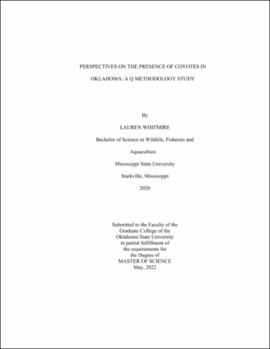| dc.contributor.advisor | Riggs, Angel | |
| dc.contributor.author | Whitmire, Lauren | |
| dc.date.accessioned | 2023-03-16T16:56:43Z | |
| dc.date.available | 2023-03-16T16:56:43Z | |
| dc.date.issued | 2022-05 | |
| dc.identifier.uri | https://hdl.handle.net/11244/337102 | |
| dc.description.abstract | Increased urbanization across the United States has led to a growing interface between natural areas and human habitat (Radeloff et al., 2005; Theobald & Romme, 2007). With this growing interface comes more wildlife species adapting to urban environments (Bateman & Fleming, 2012) and increased interactions between humans and wildlife (Bar-Massada et al., 2014; Soulsbury & White, 2015). As interactions and experience with wildlife, such as coyotes, becomes more prominent, wildlife managers need to understand residents' perceptions of these urban-adapted species to create effective management plans which are understood and supported by the public (Bright & Burtz, 2006; Madden, 2004). | |
| dc.description.abstract | This study focused specifically on coyotes, which are often viewed more negatively than other urban wildlife (Gehrt, 2007; Hunold & Lloro, 2019), and studies have shown residents' perceptions of coyotes vary based on location, experiences, information received about coyotes, and other factors (Leong, 2009; Wieczorek Hudenko et al., 2008). However, perceptions of coyotes among Oklahoma residents have not been studied. This study employed Q methodology, which is the scientific study of people's subjective thoughts and opinions (Brown, 1980). Thirty-one Oklahoma residents participated by sorting a set of 38 statements about coyotes according to the condition of instruction: "What are your thoughts about coyotes in human spaces?" | |
| dc.description.abstract | Data analysis using R (R Core Team, 2021) resulted in two factors representing Oklahoma resident perceptions of coyotes: the Content Advocate and the Cautious Urbanite. The Content Advocate has a high respect for coyotes and the environment, is well-informed, and is not concerned about danger from coyotes. The Cautious Urbanite has had fewer experiences with coyotes, is concerned about coyotes becoming a problem, and prefers more separation between people and coyotes. This study identified two perspectives Oklahoma residents hold about coyotes. | |
| dc.description.abstract | The findings of this study indicate there is a gap in information from Oklahoma wildlife managers to the public about coyotes. Further research investigating the causes behind these perspectives, such as media messaging, could benefit wildlife managers and local officials in addressing this gap. | |
| dc.format | application/pdf | |
| dc.language | en_US | |
| dc.rights | Copyright is held by the author who has granted the Oklahoma State University Library the non-exclusive right to share this material in its institutional repository. Contact Digital Library Services at lib-dls@okstate.edu or 405-744-9161 for the permission policy on the use, reproduction or distribution of this material. | |
| dc.title | Perspectives on the presence of coyotes in Oklahoma: A Q methodology study | |
| dc.contributor.committeeMember | Settle, Quisto | |
| dc.contributor.committeeMember | Hickman, Karen | |
| osu.filename | Whitmire_okstate_0664M_17698.pdf | |
| osu.accesstype | Open Access | |
| dc.type.genre | Thesis | |
| dc.type.material | Text | |
| dc.subject.keywords | coyotes | |
| dc.subject.keywords | Oklahoma | |
| dc.subject.keywords | public perceptions | |
| dc.subject.keywords | Q methodology | |
| dc.subject.keywords | wildlife management | |
| thesis.degree.discipline | Agricultural Communications | |
| thesis.degree.grantor | Oklahoma State University | |
